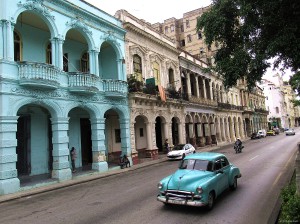By Andy Brack, Havana, Cuba, Aug. 27, 2015 | In dozens of ways, Cuba isn’t ready for the prime-time expectations of a projected tidal wave of Americans unfettered by decades of travel restrictions.
 Yes, these new yanqui explorers to the 776-mile-long island south of Florida will be able to smoke smooth Cohiba cigars, drink potent mojitos and see shiny 1950s Chevys, Fords and Plymouths powered by a hodge-podge of Russian, American and Chinese engine parts.
Yes, these new yanqui explorers to the 776-mile-long island south of Florida will be able to smoke smooth Cohiba cigars, drink potent mojitos and see shiny 1950s Chevys, Fords and Plymouths powered by a hodge-podge of Russian, American and Chinese engine parts.
But they’ll also find a country trying hard to come back from decades of decay to mile after mile of noble colonial buildings, Neo-Classical gems and ugly, pre-fabricated Soviet-era cubes. Most American’s will not be ready for the dearth of air-conditioning, Internet service or clean toilets that work. They’ll find two different currencies — one for Cubans and another for tourists — as befuddling as the maddening hours of hurdles required to make a simple call from a pay phone to South Carolina. They’ll marvel at generally clean streets and sidewalks, but wonder about why they’re crumbling and pocked by potholes.
And then there’s the ever-present heat that will make older Americans recall when they grew up and younger ones wonder how anyone can live in a country where glass in windows is the exception, not the rule. It’s common here for front doors and shutters to be open in grand, neglected buildings and in small, squalid shotgun-type houses in the rural areas where peasants watch television in the dark in the daytime to keep from using electricity.
Today’s Cuba is stuck in the past for two big reasons. First, a 1959 revolution turned the country into a socialist state that nationalized private enterprises. It insulated itself to provide free education, health care, housing and food to teeming hordes of peasants. Second came an American embargo in the early 1960s that failed to cause Cuba to democratize. But it did kept the island, once the playground of millionaires and the mafia, from looking much different from its rich neighbor to the north. These days, Cubans live in a time warp without McDonald’s, WalMart and the consumer choices that Americans take for granted.
Soon after you get off a plane at the small Jose Marti airport west of this city of 2 million, you’re told to drink lots of bottled water to keep hydrated and ward off the debilitating effects of ever-present humidity that leeches moisture from your body. Night or day, everyone has an omnipresent sheen — what polite Southerners call a “glow” — of perspiration.
What you quickly encounter driving around Havana is mile upon mile of benign neglect of once grand buildings, often stained brown and black with grime. The whole city needs a good pressure washing. Along the Malecon seawall that stretches for miles along the coast along the north coast, clothes may dry on makeshift lines in open windows of a worn, once grand 19th century edifice. Juxtaposed next door may be a renovated Baroque building that could be in Charleston and where well-heeled diners enjoy the view of the sea.
There’s a thick feeling of anticipation in the old tourist part of Havana. You can see it in people’s eyes — “the Americans are coming.” It seems to fuel the new sidewalks, re-bricked streets and renovations to churches and old buildings. Vendors selling books, trinkets, T-shirts and leather goods offer warm smiles and greetings about how they love Americans.
After spending more than a week in Cuba with a group from Magnolia Plantation and Gardens, it’s easy to wonder whether thawing relations with the United States will actually improve Cuba or change it into something that becomes just another Caribbean experience. It’s pretty neat, for example, not to be assaulted by billboards and advertising images at each corner. While Cubans appear to be able to access CNN, Weather Channel, sports and Disney, it’s clear Cuba’s current and future leaders have a challenging task — whether they can modernize but protect the island from the over-commercialization that helped to fuel the revolution in the first place.
Andy Brack is editor and publisher of Charleston Currents and Statehouse Report, where this commentary first appeared. Have a comment? Send to: editor@charlestoncurrents.com.





 We Can Do Better, South Carolina!
We Can Do Better, South Carolina!
























